Blue Heliotrope Weed Management Guide
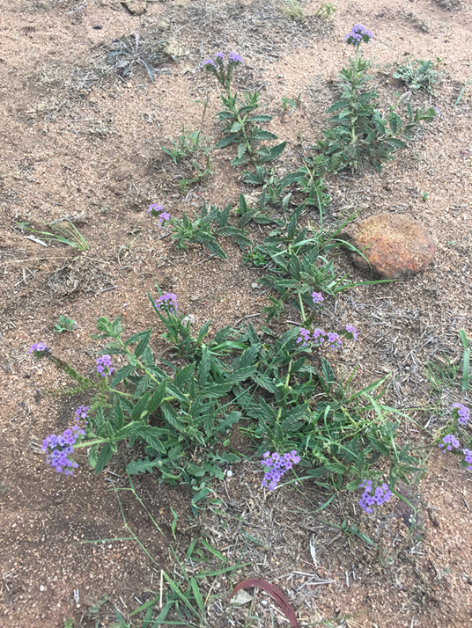 The aggressive summer-active perennial, Blue Heliotrope – Heliotropium amplexicaule – is a major agricultural weed in NSW that requires a long term strategy for successful control.
The aggressive summer-active perennial, Blue Heliotrope – Heliotropium amplexicaule – is a major agricultural weed in NSW that requires a long term strategy for successful control.
Blue heliotrope occupies over 110 000 hectares in NSW. It is unpalatable to stock, but when it is eaten, it can cause liver damage, photosensitisation or sudden death in pigs, horses, cattle, sheep and goats.
Blue heliotrope is drought tolerant due to its long taproot and complex system of lateral roots that occur throughout the soil profile. It is able to store energy in its roots and is often the first plant to respond after opening summer rain. Heliotrope robs moisture from desirable annual and perennial pasture plants.
How to identify Blue Heliotrope
Blue heliotrope is relatively easy to identify featuring clusters of small mauve, yellow-centred flowers along a coiled stem with hairy soft green foliage and a pungent odour. It is a summer growing, prostrate perennial which can be 15 to 30cm high and 30 to 200cm in diameter. The leaves are spear shaped and a dull green. The stem, like the leaves are hairy. The flower is possibly the most distinguishing feature, being bluish-purple with yellow centres. Like many plants in the Boraginaceae family, flowers are in dense clusters along one side of a coiled stalk, often referred to as a fiddle neck.
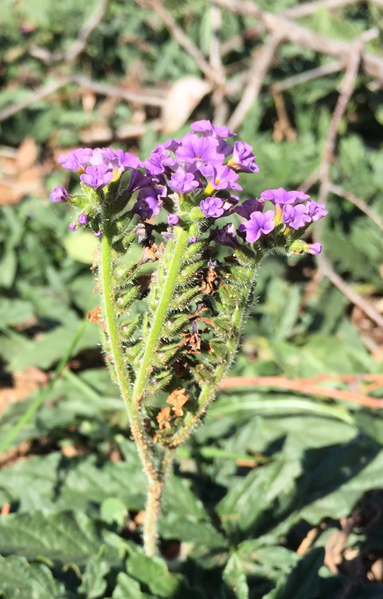
The “fiddle neck” appearance of the flower stalk is a distinguishing feature
Why is Blue Heliotrope problem?
This South American native herb, if left un-checked, is a drought-hardy invasive weed that will out-compete depleted pastures and rapidly populate bare ground.
Blue Heliotrope is notoriously difficult to manage and costly to control often leaving a blue haze across paddocks and a dent in farm profit margins from Spring right through to Autumn.
The spreading plant rapidly populates cropping and pasture paddocks regenerating from fragments of its strong tap root and from sticky seed heads which commonly hitch a ride on machinery, native animals and livestock.
Blue Heliotrope is toxic to all classes of livestock with high levels of alkaloids causing liver damage and potentially, stock deaths. Although animals tend to only graze the weed when hungry and alternative pasture is scarce, the weed is toxic both fresh and dried so careful management is required for grazing, spraying or making hay in infested paddocks. Local Land Services is committed to assisting producers access advice to combat problem weeds.
Controlling Blue Heliotrope
Blue heliotrope is difficult to control in cropping situations. Often in fallows, its hairy leaves limit herbicide uptake, which can be aggravated by dust held on the leaves. Often herbicides will only kill the top of the plant, leaving it to re-shoot from the root system. Broadleaf specific chemicals such as 2,4-D can exacerbate this.
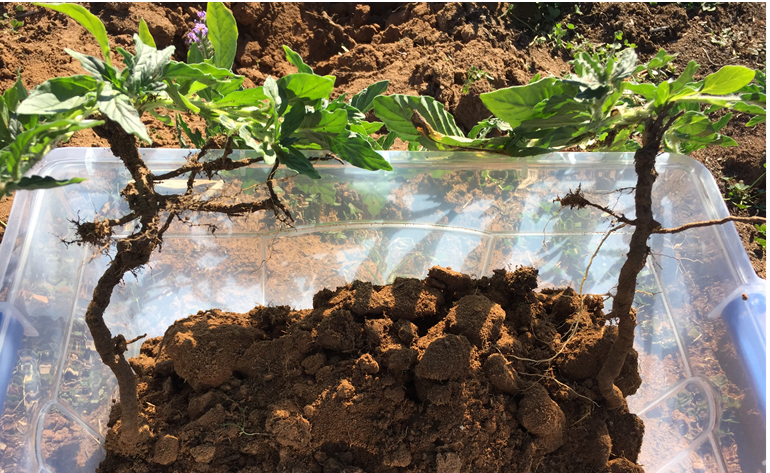
The large and complex root system of Blue Heliotrope make it well adapted to dry conditions (photo: C Thompson).
Limiting spread
Blue heliotrope is difficult to control, so limiting its spread is very important. It can spread by seed or by root fragments. Seed can stick to clothing or animals and can be found in fodder or on machinery. Some seed can be viable after travelling through animal’s digestive systems. Root fragments can be spread by machinery, particularly cultivation machinery or graders, as well as washed down stream and spread via waterways.
If blue heliotrope has established in a new area, it is important to control it before the population gets too high. Isolated plants can be dug up, but ensure that all roots are removed or they could re-shoot.
Chemical control
There are a number of different chemicals registered for spot spraying blue heliotrope. Care needs to be taken when using some of these products in bushland or legume dominant pastures as many broadleaf plants are susceptible to these products. Always consult your agronomist and read the label prior to using any herbicides.
Competitive pasture
One of the best ways to prevent establishment of heliotrope is by maintaining groundcover with a competitive pasture. By managing fertility and grazing pressure, you can reduce bare soil, reducing the opportunity for weeds to germinate and establish.
Local Land Services Upper Hunter partnership demonstration sites have shown effective control of Blue Heliotrope requires commitment to an integrated management strategy where soil health and nurture of beneficial plant species is as vital as suppressing the weed invader.
This guide is designed to step you through the process to form a plan of management for controlling this major agricultural weed on your property. The aim is through engaging a mix of tools tailored for your farm business to minimise potential production losses and establish a path to long term success.
Grazing control
If you are dealing with large areas of established blue heliotrope, control becomes more difficult. Cultivation is not a good option as it spreads root fragments, often causing a greater problem. Grazing can be used to help control blue Heliotrope. Sheep and goats can be used to manage heliotrope, provided a different group of animals is used each year. Merinos have the greatest tolerance and adult wethers should be used rather than breeding ewes or juveniles. Horses, pigs and cattle should never be used in the grazing management of blue heliotrope
If the paddock is completely overtaken by blue heliotrope and pasture re-establishment needs to take place, reduce weed seed banks by growing cereal crops for at least three years, with a strong focus on effective summer fallows. Be mindful that fallow applications containing 2,4-D may decrease the effectiveness of blue heliotrope control. Again, speak to an agronomist. Chose a perennial grass species that is most competitive in summer for re-sowing.
Biological control
Blue heliotrope leaf-beetle (Deuterocampta quadrijuga) is a biological control agent that eats Blue heliotrope. There has been some success with releases in the Capertree Valley, but to date limited success in other parts of NSW. This is because beetles will not establish and lay eggs on plants that are suffering from moisture stress, so it has been hard for them to naturalise with the tough summers we have been experiencing. The leaf beetle will not eradicate blue heliotrope, but with careful management, it may provide an extra management option.
Blue heliotrope is easiest to manage when it is moving into a new area. Be on the lookout and if you see it, control it early. For more information, check out the links below or contact your local LLS ag advisor.
Weed Management Plan For Blue Heliotrope
1. Identification
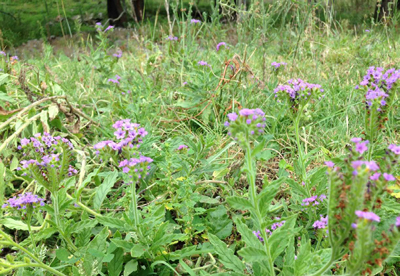 Map where Blue Heliotrope occurs on your property.
Map where Blue Heliotrope occurs on your property.
Is it in on arable or non-arable country? How much of your production area is infested with the weed? How heavy is the infestation – scattered plants or the weed represents more than 50% of your plant species? What are productive plant species are present, broad-leaf and grasses?
Rate the potential productivity of your paddock areas assuming they were weed-free. How effective is your Farm Biosecurity Plan for minimising weed spread? Do you regularly clean down machinery and equipment and minimise stock movements when Blue Heliotrope goes to seed?
2. Planning
Once you have identified the extent and severity of your Blue Heliotrope problem, you are ready to design a plan of attack for your property.
The key to successful Blue Heliotrope management is to set a plan and then stick to it. Do not get ahead of yourself. Work on one section at a time to bring the weed under control before moving onto the next stage of your plan.
Monitor your successes and failures. If applicable, start with arable country to bring any previously cropped paddocks that are now predominately Blue Heliotrope, back into your production system.
In pasture paddocks, identify the heaviest infestations and make those your priority. Once you have achieved reasonable control of Blue Heliotrope in these paddocks, prioritise your focus in order of productivity or carrying capacity.
3. Management tools
Blue Heliotrope is successful at invading your pasture systems purely due to its ability to rapidly grow after a rainfall event either with limited competition from established pastures or as an opportunist on bare ground.
For this reason, you need to “fight fire with fire”, as Central NSW-based agronomist, Bob Freebairn recommends, and ensure your pasture system has the competitive edge against this aggressive weed.
Avoid over-grazing non-arable country and combine pasture management with a timely chemical control program. On arable country, the key to success is reducing weed numbers, sowing a competitive pasture mix and improving soil health so that your preferred species are fit and ready to out-compete Blue Heliotrope in the battle for nutrients, sunlight and moisture.
Adopt and stick to a strict farm biosecurity plan managing all machinery and stock movements.
Subtropical pastures
Sub-Tropical Grasses are one of the best plant species equipped to out-compete Blue Heliotrope and bring your paddocks back into production. Sub-tropical grasses are equally if not more aggressive ONCE ESTABLISHED than Blue Heliotrope with a rapid growth rate critically subduing the weed’s activity through the summer months.
Sub-tropicals out compete Blue Heliotrope for ground cover, sunlight, nutrients and moisture during this period unlike many temperate grass species. Sub-tropical pastures can be hard to establish, so a management plan must be implemented to ensure success. Even though established plants are aggressive in growth habit, tropical grass seedlings are quite the opposite.
Annual Grass weeds such as Liverseed grass and summer grasses need to be controlled for three years prior to sowing of a subtropical pasture. Ground cover is also important when establishing sub-tropicals to keep the seedbed moist and insulated from drying out. Species selection will vary according to soil type and location so please consult your local agronomists and seed merchants.
Herbicide control
Herbicide Control of Blue Heliotrope in high plant populations is an essential component of a broad integrated management strategy.
Blue Heliotrope is not an easy plant to kill in pastures with a chemical application. The key learnings from the 2020 Hunter Local Land Services Blue Heliotrope Management Demonstration at Merriwa include:
- Timing of chemical application was critical. Often this weed is sprayed too late for optimum results and control and “the horse has bolted”. The best chemical control results were achieved when the weed was sprayed 1-2 days following a rainfall event before summer temperatures started to stress the weed and before chemical contact/coverage was impeded by grasses in the top of the canopy. When Blue Heliotrope was sprayed 14 days post rainfall and after some hot weather, a reduction in chemical control was observed.
- Water rates were an important factor in successful control. To achieve maximum kill results when broadacre spraying Blue Heliotrope, a water rate of no less than 100L/ha should be applied. This ensures good coverage of the chemical on the plant leaves.
- Chemical treatment and rate selection require individual decisions for each situation. Observations were made at the Hunter Local Land Services Blue Heliotrope Demonstration site of a variety of chemical treatments and the relative effectiveness of control options. Selections will vary depending on cropping rotation and pasture species mixes. Consult your local agronomist or advisor to discuss which chemical treatment suits your individual production system as recommendations will vary.
Soil health
Soil Health plays an important role in the management of Blue Heliotrope, especially in native pastures.
If the pasture system is not performing, how can it compete against an aggressive weed? Have your pastures enough legumes (eg. clovers) in the pasture composition during winter to drive summer production? Are your soil phosphate and sulphate readings at a level to promote productive pasture growth?
Are your productive species under pest attack? Not only will soil health improve the pasture quality, but it will also promote pasture growth to increase ground cover.
Monitor your soil and plant health in consultation with your local agronomist.
Biological control
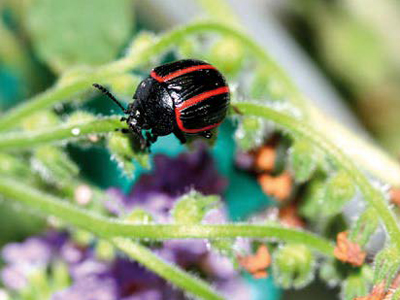 Biological Control options in Australia for this South American native weed are limited to an introduced Blue Heliotrope leafbeetle – Deuterocampta quadrijuga – which has proved difficult to establish.
Biological Control options in Australia for this South American native weed are limited to an introduced Blue Heliotrope leafbeetle – Deuterocampta quadrijuga – which has proved difficult to establish.
The beetle is not adapted to our long hot summers however will thrive in cooler sheltered riparian zones stripping Blue Heliotrope plants of foliage.
4. Time
Blue Heliotrope takes time to manage. It cannot be controlled in just one strategy or one spray therefore a plan of attack needs to be implemented to meet the goals of your farming system. Where possible partner and network with your neighbours and share learnings to improve outcomes for your district.
Remember, plant competition and chemical treatment timing are critical tools when engaging an integrated control program for this weed.
Seek advice – formulate a plan –and stay focused in the battle to control Blue Heliotrope and improve your farm productivity.
Hunter Local Land Services Heliotrope control demonstration site
Upper Hunter beef producer, Col Bates and his family have been battling Blue Heliotrope for the past five years.
After a Hunter Local Land Services field trip to Binnaway with agronomist, Bob Freebairn in 2016, they learnt about the benefits of harnessing tropical pastures to supress summer weed activity and set about establishing a long-term weed control plan for their ‘Kingslyn’ property on the Merriwa River.
Three years down the track, ‘Kingslyn’ was chosen as the perfect site for the Hunter Local Land Services Blue Heliotrope Control Demonstration in partnership with the Bates family and agronomist, Dan Clydsdale of Clydsdale Rural. In January 2020, a series of chemical treatments, rates and spray timings were applied to a native pasture system infested with Blue Heliotrope and the results compared.
This planning guide has drawn together many of the key learnings from this property and tips to maximise herbicide control success.
In addition, the Bates family has provided valuable feedback on a variety of tropical pasture mixes they have established to out-compete Blue Heliotrope and boost pasture production. Visit the Hunter Local Land Services website for links to the Drought Recovery video series including the Weed Management - Blue Heliotrope episode filmed at the Demonstration site on ‘Kingslyn’.
Hunter Local Land Services pasture demonstration site
The Hunter Local Land Services Merriwa Pasture Demonstration Site was established in 2016 to assess the performance of sub-tropical grass species on the heavy black soils in the Upper Hunter.
The successful site has developed to host a mix of sub-tropical grasses, temperate and tropical legume species, a Hunter Soil Moisture Network soil-probe and weather station, all in an active pasture system on the Alker family’s ‘Alcherinca’ property.
Managed by Local Land Services Agricultural Extension Officer, Sarah Giblin in partnership with seed companies, the accessible site is just 10km from Merriwa on the Scone Road.
Promising performers through the drought with potential for inclusion in local farming systems and weed management plans include sub-tropical grasses, Purple Pigeon, Gatton Panic and Blue Flouren, and new improved winter legumes, sub-clovers and medics.
Also impressive was the drought-hardy and bloat resistant sub-tropical legume, Desmanthus. Visit the Hunter Local Land Services website for links to video and event updates on the Pasture Demonstration Site and access to the Hunter Soil Moisture Network platform for live updates on soil moisture and weather from across the region.
Resources
Statewide
Download the Blue Heliotrope best practice manual.
Hunter
Download the Hunter Blue Heliotrope guide.
Central West
Download the Central West Blue Heliotrope guide.
Adapted from content by Senior Land Services Officer, Callen Thompson.